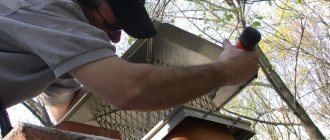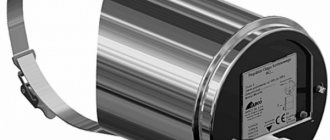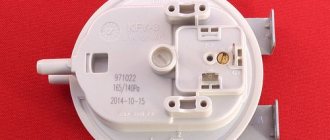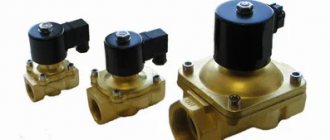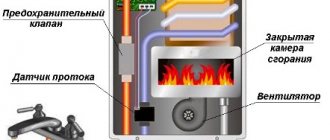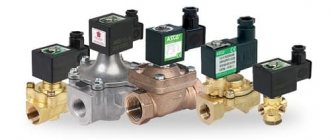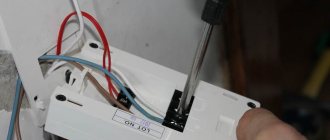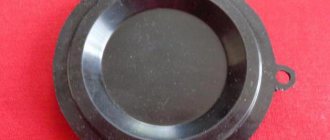Home / Gas boilers
Back
Published: 05/29/2019
Reading time: 2 min
0
5934
The gas boiler draft sensor is designed to ensure safety. This device is an automatic device that protects against excessive accumulation of harmful gas in the room and is responsible for trouble-free operation.
- 1 Types of gas boiler draft sensor
- 2 How it works
- 3 Functionality check
- 4 Installation of the draft sensor
- 5 What to do if there is no traction
- 6 Is it possible to disable
Description and purpose of the traction sensor
The safety element ensures safe operation of the equipment. The draft sensor of a suspended and floor-standing gas boiler is responsible for turning off the device when carbon monoxide accumulates. The presence of sufficient draft in the device ensures the replacement of combustion products with fresh air, which ensures safety.
The function of the draft sensor is to send a message to the system valve that the air vacuum is insufficient and an intense accumulation of carbon monoxide may occur. As soon as a draft violation message is received, the valve turns off the device.
Insufficient exhaust air suction leads to the phenomenon of “backdraft”. The release of combustion products does not occur through the chimney channels, but into the room in which the equipment is installed.
How to check and disable sensors
If you want the equipment to function normally, then you cannot disable the protection. When the device turns off some time after heating, this already indicates that the sensors are working properly. It’s another matter when the display displays an error code with instructions to check the part. Then the contacts are disconnected, and the protective device is tested with a multimeter.
To ensure that equipment and its security systems work properly, clean the components and parts from blockages and scale. Thus, scale fouling of the heat exchanger leads to untimely operation of the thermal relay. Therefore, use reagents to clean it.
The safety system for gas equipment is very important. Therefore, before purchasing, study the components of the speakers; they are usually indicated in the equipment documentation.
The principle of operation of the draft sensor in a gas water heater
Combustion products from the firebox flow through the chimney to the street. If the level of air suction in the duct is reduced, smoke occurs in the room. The room is filled with carbon monoxide, which has a detrimental effect on humans. Poisoning from its vapors can lead to suffocation.
Attention! If carbon monoxide has accumulated in the room, it is necessary to intensively ventilate the apartment (open all windows), close the doors to adjacent rooms and call gas specialists.
The draft sensor consists of:
- bimetallic plate;
- plugs;
- nuts;
- fitting.
The bimetallic relay signals the shutter valve to turn the boiler system on or off.
The thermal relay consists of a bimetallic plate with movable contacts
The temperature of the exhaust gas located in the chimney depends on the intensity of fresh air suction. The better the traction, the lower it is. When heated, the bimetallic plate expands, which leads to disconnection of the contact when the temperature reaches a critical value.
Gas boilers operate on natural and liquefied gas. In the first case, the normal range is considered to be 75-950 0C. In the second case, adequate operation of the boiler occurs when the gas is heated within the range of 75-1500 0C.
The calorie content of liquefied propane butane gas is higher than natural gas. Therefore, the combustion temperature also increases. The thermal relay is set to turn off at 950 0C for natural gas and at 1500 0C for propane-butane devices.
The draft sensor of the AOGV gas boiler is located in the area of action of the wick and is connected to the electromagnetic element of the circuit, which opens the gas supply.
The gas supply control circuit of the AOGV boiler requires the presence of a temperature sensor
The thermocouple electrode is located near the igniter. While it is heating up, the gas supply does not stop. As soon as the electrode has cooled, the supply is closed.
Device and principle of operation
The main principle of operation of a gas boiler draft sensor is the closing and opening of contacts.
It works according to the laws of physics, thereby controlling the temperature of the burned fuel. When the temperature indicator shifts into an unacceptable zone, the draft sensor transmits a corresponding signal to the electronic control unit of the boiler.
The type of sensor directly depends on the type and design of the gas boiler in which it is installed.
Boiler with natural draft and open combustion chamber
The main element is a plate consisting of two metals that have different deformation characteristics due to heating, as well as two contacts that are brought together and separated by these plates. As a rule, one of these plates is fixedly fixed to the sensor body, and the second is deformed due to thermal effects.
The sensor must match the fuel type. If the boiler operates on compressed natural gas, the sensor must operate in the temperature range from 95 to 950 °C, if on liquefied gas - from 75 to 1500 °C.
If the traction force becomes less, burnt gases accumulate. Due to this malfunction, the temperature of the measuring device increases. The bimetallic plate opens the contacts and the gas supply to the burner stops, that is, the boiler control unit performs an emergency shutdown.
Work will resume when the sensor cools down and its temperature drops within the appropriate range. This means that it also acts as a thermostat.
With forced draft and closed combustion chamber
In this case, the draft sensor has a pneumatic relay design with a very sensitive membrane. The blowing device creates strong draft and movement of burnt gases. Under their influence, the membrane is deformed and closes the sensor contacts. At this time, the control unit detects normal operation of the boiler with sufficient draft.
But, with insufficient traction, there is not enough force to displace the membrane and it returns to its original position. The contacts open and the heating device stops operating.
With condensing heating type
The sensors, as on boilers with natural draft, operate on the principle of deforming a bimetallic plate, but are set by the manufacturer to a lower temperature regime.
Types of traction sensors
The relay device is distinguished according to the principle of operation of the combustion chamber. There are 2 types of construction: open and closed. A draft sensor operates in a gas boiler with an open view of the combustion chamber. Install it in the smoke eliminator. The gas supply stops if the bimetal exceeds the expansion rate, breaking the contact in the circuit. The valve reacts to the signal and blocks movement to the igniter.
Boilers with an open combustion chamber pose a danger in the form of reverse draft. It occurs if:
- the chimney is clogged with debris and rubbish;
- A strong gusty wind is blowing, which blows the system.
In this case, carbon monoxide smoke is drawn from the chimney into the room. The traction sensor is not designed for such cases, so experts additionally advise installing a gas sensor. This will prevent accidents from occurring.
In gas boilers with a closed type of combustion chamber, a pneumatic relay is installed. Its job is to control the fan, which creates forced draft and helps draw combustion products into the chimney and discharge them outside.
There are wired and wireless sensors. The first alarms require additional installation to the wire connections. Wireless relays operate from a radio signal. Such sensors are installed in cases where the operation of the device is monitored from another room.
The wireless alarm system consists of 2 blocks. The first is installed near the boiler and connected to its terminals, and the second - in the room from which the equipment is controlled. These blocks are connected by a radio signal. The controller is equipped with a keyboard and display for easy operation.
Based on the functions they perform, thermostats are divided into simple and programmable. The first relays perform only one task: monitor the set temperature. Programmable alarms can perform the functions necessary to analyze the operation of the boiler remotely:
- setting the temperature regime for daytime and nighttime operation;
- programming the device by day of the week;
- monitoring indoor humidity (in this case, the device is additionally equipped with a hydrostat);
- maintaining a given humidity parameter.
The type of draft sensor depends on the operating principle of the gas boiler
Incorrect placement of the chimney contributes to the wind blowing in and extinguishing the burner. To prevent such cases from occurring, experts advise additionally installing a stabilizer.
How to install a gas boiler draft sensor
Experts recommend installing heating equipment in a separate room. To do this, choose the coldest room without radiators. The draft sensor is installed on the gas boiler. The heater is located in a place protected from sunlight. Also, the room should be away from drafts. The building cannot be located in a windy area to avoid the possibility of burner extinguishing.
Using a terminal, a thermostat is attached to the gas boiler. If it is necessary to install additional equipment, study the instructions from the manufacturer. Different boiler models have their own installation nuances, so it is important to follow these recommendations.
The thermal relay is installed using clamps that extend from the thermostat or heat exchanger
If the device needs to be placed outside the speaker housing, it is released from the front panel. At the installation site, prepare a recess according to the dimensions of the relay, and provide the box with a lid so that it is possible to replace the element if it breaks.
Attention! Experts recommend removing the thermostat when installing heated floors in order to monitor the performance of the system.
The heating cable is connected to the contacts, and the sensor to the terminals. Attach the power cord and perform packaging. The front panel is placed on top and closed with a lid.
How to check functionality?
Changing the draft sensor of a gas boiler may be necessary in the event of serious malfunctions in the functioning of the heating equipment. For example, if the boiler is constantly switched off, and there are no significant problems in the chimney system. Or if the controller starts working, and after an average of 25 minutes it turns off. The next start begins only after the sensor has completely cooled down.
How to check the draft sensor of a gas boiler:
A mirror is attached in the place where the sensor is attached. During the operation of boiler equipment, the surface should not sweat.
You can check the flue gas sensor by partially closing the chimney with the damper. If all is well, the boiler should turn off immediately.
The double-circuit unit is switched to hot water supply mode without heating. Open the tap completely. If the controller turns off in this mode, then there is a high probability that the problem lies in this traction sensor.
On the market of boiler equipment and accessories for it, many manufacturers offer gas boiler draft sensors. Of these, Eurosit, Sitgroup, KARE, Junkers, Dion and others.
All controllers apply to different units:
- to wall;
- floor boilers;
- geysers.
Therefore, monitor the functionality of the gas boiler draft sensor.
Number of blocks: 11 | Total number of characters: 19678 Number of donors used: 5 Information on each donor:
The most important thing you need to pay attention to when operating fire and explosive devices, which include a gas boiler, is safety issues . Modern gas boilers are equipped with special automatic systems that prevent the flame from blowing out in the igniter and a possible gas explosion. An important element of the system is the gas boiler draft sensor.
It is needed in order to send a signal to the valve responsible for supplying fuel to the gas burner in cases programmed by the manufacturer. Such cases include improper draft inside the device, when air with combustion products begins to penetrate into the living space, and does not move naturally from the boiler to the chimney.
Checking the gas boiler draft sensor
The thermal relay is replaced if the normal functioning of the device is disrupted. If no problems are found in the chimney, and nothing prevents the exit of combustion products, and the boiler constantly turns off, specialists check the working condition of the alarm.
You can check the draft sensor of a gas boiler with a multimeter and other methods:
- Install a mirror near the relay. If the boiler becomes wet during operation, the sensor is faulty.
- The chimney is not tightly covered with a damper. If the thermostat is working properly, the heater turns off.
- When checking the pneumatic relay of a double-circuit device, turn off the heating system, leaving the workers only heating hot water, and open the tap. If the system turns off, then the problem is with the thermostat.
Check the serviceability of the thermostat with a multimeter
All types of alarms are used for various modifications of wall-mounted and floor-mounted heating devices.
Is it possible to disable
When installing the sensor and using gas equipment, you can often observe periodic shutdowns in operation. In this case, you may want to turn off the traction device completely. However, there is no need to rush.
Draft sensor for gas boiler AOGV and AKGV
There are several reasons for this:
- Firstly, a sensor disconnection may indicate poor traction performance. Weak intensity of movement of smoke gases leads to overturning of the draft in boiler equipment. Harmful fumes will enter the house in large quantities.
- Secondly, the problem may be backdraft. An air lock forms. The exhaust gases of the smoke move to a certain point in the chimney and then fall back. This occurs due to poor heating of the pipe and poor thermal insulation.
Of course, theoretically it is possible to disable the sensor, but this entails great danger. If an emergency suddenly arises, there will be no protection. Therefore, it is not recommended to operate a gas unit without such a controller.
Reasons for triggering the traction sensor
Problems with the actuation system or wind may cause the system to shut down. The most common reasons for the thermostat to trip:
- gusty wind;
- chimney blockage;
- incorrect installation of the boiler or chimney, incorrect calculations;
- fan shutdown.
Gusty wind
To prevent a gust of wind from extinguishing the burner, experts recommend installing a stabilizer. It is mounted at the outlet pipe.
Chimney blockage
Debris in the chimney serves as an obstacle to the removal of combustion products. The draft is reduced, and carbon monoxide is not released into the street. The system overheats and the device shuts down. In this case, the problem is eliminated by cleaning the chimney.
Incorrect installation
If errors were made in calculations or installation during installation. Carry out control measurements and check the correct installation of the boiler and chimney. The height of the outlet is calculated depending on the location of the pipe from the ridge. Experts recommend placing it in the center of the roof. The head is placed 50 cm above the ridge.
Disabling the fan
Turning off the fan stops the supply ventilation, and carbon monoxide is not discharged to the street. In this case, the reason for stopping the operation of the ventilation system is identified.
Experts recommend performing a seasonal preventive inspection of the heating device in the fall and spring. Operating the boiler without a thermostat is not recommended.
Functionality check
All of the above can be combined into one whole: the sensor is necessary in order to shut off the fuel supply in the event of a danger - such as a gas leak or poor removal of combustion products.
If this is not done, then very sad consequences are possible. Carbon monoxide poisoning has already been discussed more than once above. It very often leads to death, and it’s definitely not worth joking with. And if the burner suddenly goes out, but the gas continues to flow, sooner or later an explosion will occur. In general, it is clear that the sensor is vital.
But it can fully perform its functions only in good condition. It is common for any equipment to fail periodically. Failure of this part will not affect the external condition of the boiler in any way, so it is very important to regularly check the functionality of the element. Otherwise, you risk noticing the problem only when it is too late.
There are several methods for checking:
- attach a mirror to the area where the sensor is installed. During operation of the gas water heater, it should not fog up. If it remains clean, then everything is fine;
- partially block the exhaust pipe with the damper. In case of normal operation, the sensor should react instantly and turn off the boiler. For safety reasons, do not test for too long to avoid carbon monoxide poisoning.
If in both cases the testing showed that everything is in order, it means that the element being tested is ready at any time to react to an unforeseen situation and turn off the gas supply. But there is another type of problem - when the sensor is triggered just like that.
If you have carefully checked the draft level and other aspects, but the boiler still turns off, this means that the control element is not working correctly. You can further test this as follows.
Disconnect the element and test it with an ohmmeter. The resistance of a working sensor should be equal to infinity. If this is not the case, then the part has failed. There is only one option to correct the situation - you need to replace the broken element.
Some homeowners, in situations where the sensor suddenly begins to constantly interrupt the fuel supply in the absence of visible problems with the chimney draft, decide to simply turn off this element. Of course, after this the column starts working smoothly.
But such actions are a direct violation of safety regulations when operating gas equipment. By turning off the sensor, you cannot be sure that everything is in order with the draft and that carbon monoxide does not begin to fill the room. It's definitely not worth the risk. It is better to check the performance of the part using the methods described above. You can also get information on this issue from the video posted above. Good luck to you and a safe and warm home!
How to disable the draft sensor in a gas boiler
The draft sensor of a floor-mounted and wall-mounted gas boiler is replaced in stages. Stop the heating system, remove the housing, dismantle the relay. The operation of the thermostat is analyzed and, in case of malfunction, a new one is installed.
A faulty draft sensor can lead to an air lock and reverse draft.
Disabling the thermal relay poses a great danger to human life. In the event of an emergency, it is impossible to turn on the boiler’s protective function. Therefore, experts recommend that if a thermal relay is found to be damaged, replace it immediately.

